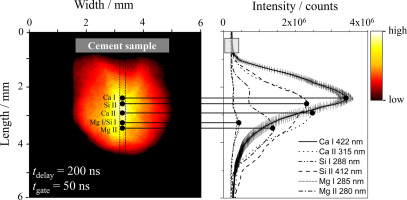当前位置:
X-MOL 学术
›
Spectrochim. Acta B. At. Spectrosc.
›
论文详情
Our official English website, www.x-mol.net, welcomes your
feedback! (Note: you will need to create a separate account there.)
Investigation of grain sizes in cement-based materials and their influence on laser-induced plasmas by shadowgraphy and plasma imaging
Spectrochimica Acta Part B: Atomic Spectroscopy ( IF 3.2 ) Pub Date : 2020-03-01 , DOI: 10.1016/j.sab.2020.105772 C. Gottlieb , A. Gojani , T. Völker , T. Günther , I. Gornushkin , G. Wilsch , J. Günster
Spectrochimica Acta Part B: Atomic Spectroscopy ( IF 3.2 ) Pub Date : 2020-03-01 , DOI: 10.1016/j.sab.2020.105772 C. Gottlieb , A. Gojani , T. Völker , T. Günther , I. Gornushkin , G. Wilsch , J. Günster

|
Abstract The effect of particle grain sizes in different cement-based mixtures on the laser-induced plasma evolution is studied using two experimental methods: (i) temporal and spatial evolution of the laser-induced shock wave is investigated using shadowgraphy and two-dimensional plasma imaging, and (ii) temporal and spatial distribution of elements in the plasma is investigated using two-dimensional spectral imaging. This study is motivated by the interest in applying laser-induced breakdown spectroscopy (LIBS) for chemical analysis of concrete, and subsequently obtain information related to damage assessment of structures like bridges and parking decks. The distribution of grain sizes is of major interest in civil engineering as for making concrete different aggregate grain sizes defined by a sieving curve (64 mm to 0.125 mm) are needed. Aggregates up to a size of 180 μm can be excluded from the data set, therefore only the amount of small aggregates with a grain size below 180 μm must be considered with LIBS. All components of the concrete with a grain size smaller than 0.125 mm are related to the flour grain content. Tested samples consisted of dry and hardened cement paste (water-cement ratio w/z = 0.5), which served as a reference. Aggregate mixtures were made by adding flour grains (size 40 μm) and silica fume (size 0.1 μm) in different ratios to cement: 10%, 30%, 50% and 60%, all combined to the remaining percentage of dry or hydrated cement. The visualization results show that a dependance in the evolution of the plasma as a function of sample grain size can be detected only in the initial stages of the plasma formation, that is, at the initial 3 μs of the plasma life. Spectral information reveals the elemental distribution of the silicon and calcium in plasma, in both neutral and ionized form. Here also, a significant effect is observed in the first 1 μs of the plasma lifetime.
中文翻译:

通过阴影成像和等离子体成像研究水泥基材料中的晶粒尺寸及其对激光诱导等离子体的影响
摘要 使用两种实验方法研究了不同水泥基混合物中颗粒粒径对激光诱导等离子体演化的影响:(i) 使用阴影成像和二维等离子体研究了激光诱导冲击波的时空演化。成像,以及 (ii) 使用二维光谱成像研究等离子体中元素的时间和空间分布。这项研究的动机是将激光诱导击穿光谱 (LIBS) 应用于混凝土的化学分析,并随后获得与桥梁和停车甲板等结构的损坏评估相关的信息。粒度分布是土木工程中的主要关注点,因为需要通过筛分曲线(64 毫米到 0.125 毫米)定义不同的骨料粒度的混凝土。可从数据集中排除最大 180 μm 的团聚体,因此 LIBS 必须只考虑粒度低于 180 μm 的小团聚体的数量。粒度小于 0.125 毫米的混凝土的所有成分都与面粉颗粒含量有关。测试样品由干燥和硬化的水泥浆组成(水灰比 w/z = 0.5),用作参考。骨料混合物是通过将面粉颗粒(尺寸 40 μm)和硅粉(尺寸 0.1 μm)以不同的比例添加到水泥中制成的:10%、30%、50% 和 60%,全部与剩余的干水泥或水合水泥的百分比相结合. 可视化结果表明,仅在等离子体形成的初始阶段,即等离子体寿命的最初 3 微秒,才能检测到等离子体演变与样品晶粒尺寸的关系。光谱信息揭示了等离子体中硅和钙的元素分布,包括中性和电离形式。同样,在等离子体寿命的前 1 μs 中也观察到了显着影响。
更新日期:2020-03-01
中文翻译:

通过阴影成像和等离子体成像研究水泥基材料中的晶粒尺寸及其对激光诱导等离子体的影响
摘要 使用两种实验方法研究了不同水泥基混合物中颗粒粒径对激光诱导等离子体演化的影响:(i) 使用阴影成像和二维等离子体研究了激光诱导冲击波的时空演化。成像,以及 (ii) 使用二维光谱成像研究等离子体中元素的时间和空间分布。这项研究的动机是将激光诱导击穿光谱 (LIBS) 应用于混凝土的化学分析,并随后获得与桥梁和停车甲板等结构的损坏评估相关的信息。粒度分布是土木工程中的主要关注点,因为需要通过筛分曲线(64 毫米到 0.125 毫米)定义不同的骨料粒度的混凝土。可从数据集中排除最大 180 μm 的团聚体,因此 LIBS 必须只考虑粒度低于 180 μm 的小团聚体的数量。粒度小于 0.125 毫米的混凝土的所有成分都与面粉颗粒含量有关。测试样品由干燥和硬化的水泥浆组成(水灰比 w/z = 0.5),用作参考。骨料混合物是通过将面粉颗粒(尺寸 40 μm)和硅粉(尺寸 0.1 μm)以不同的比例添加到水泥中制成的:10%、30%、50% 和 60%,全部与剩余的干水泥或水合水泥的百分比相结合. 可视化结果表明,仅在等离子体形成的初始阶段,即等离子体寿命的最初 3 微秒,才能检测到等离子体演变与样品晶粒尺寸的关系。光谱信息揭示了等离子体中硅和钙的元素分布,包括中性和电离形式。同样,在等离子体寿命的前 1 μs 中也观察到了显着影响。











































 京公网安备 11010802027423号
京公网安备 11010802027423号